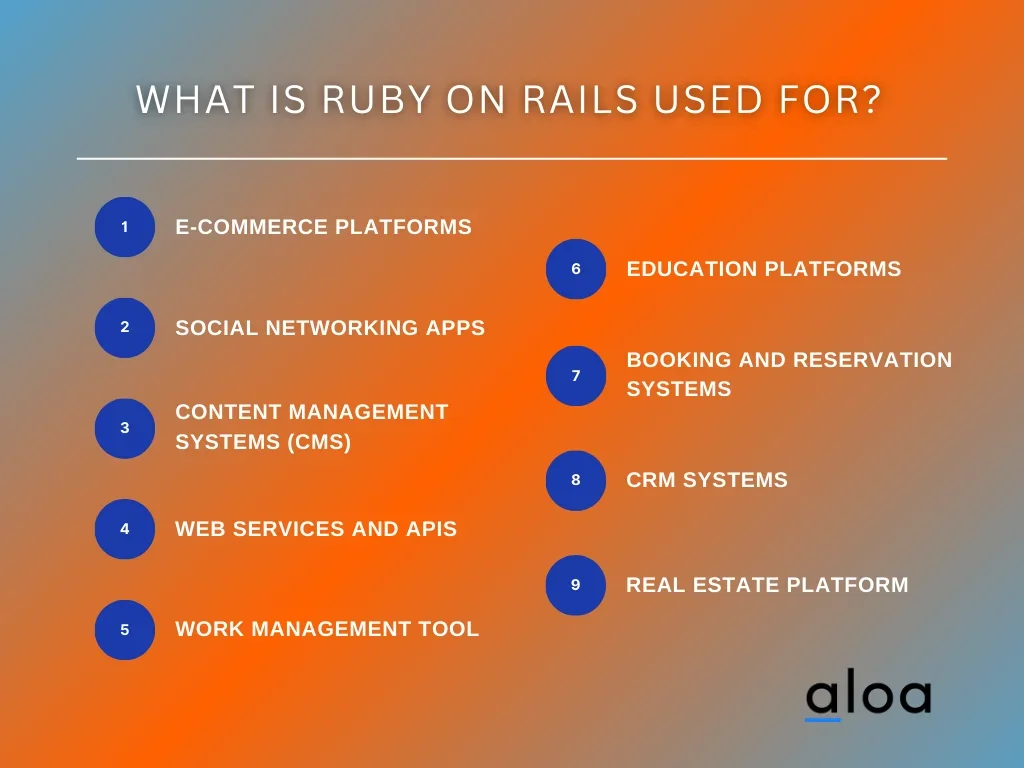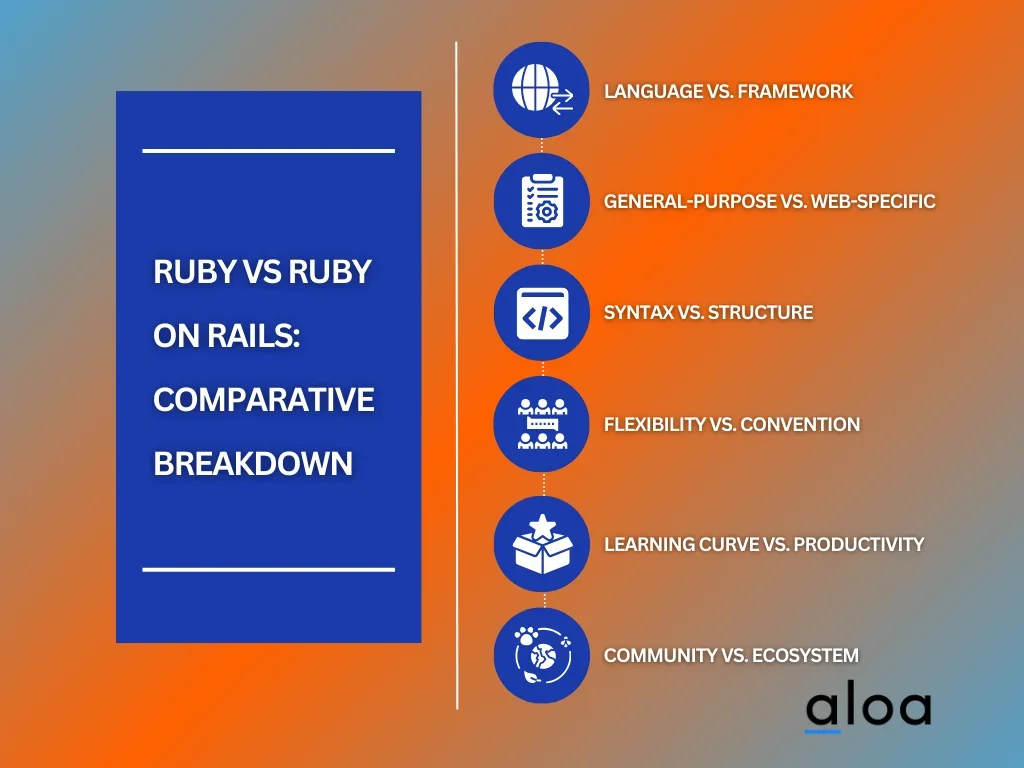The question “What’s Ruby on Rails?” inevitably arises when discussing a web application framework. Ruby on Rails is a standout framework in web development known for rapidly and efficiently building web applications. Its convention over configuration approach minimizes explicit coding, allowing developers to focus on business logic.
With an extensive ecosystem of gems and plugins, the Ruby on Rails framework expedites development by offering ready-made solutions for common functionalities.
Aloa, a software development firm, boasts developers with extensive experience in utilizing Ruby on Rails. These skilled professionals leverage Ruby on Rails to create robust and scalable web applications that meet clients’ diverse needs across industries. With a deep understanding of Ruby on Rails’ capabilities, Aloa’s software developers constantly deliver innovative solutions that drive business growth and success.
In this blog, we’ve explored what's Ruby on Rails, from its fundamental principles to its practical applications in web development. By the end of this journey, you’ll have a comprehensive understanding of what Ruby on Rails is and how it can benefit developers and businesses.
Let’s dive in!
What’s Ruby on Rails?
“What's Ruby on Rails,” a common question often asked by web developers, refers to a server-side web application framework written in the Ruby programming language. Known for its convention over configuration approach, it streamlines developer coding tasks. Its robust ecosystem and MVC pattern allows developers to build accessible web applications.
Ruby on Rails separates data, presentation, and logic with its Model-View-Controller architecture. Its convention over configuration approach minimizes explicit coding, allowing developers to focus on business logic instead of boilerplate code. Supported by a robust community and extensive ecosystem of gems and plugins, Rails Core ensures continuous improvement and compatibility with various web servers.
In 2004, David Heinemeier Hansson created Ruby on Rails while working on the project management tool Basecamp at 37signals. He extracted Ruby on Rails from the Basecamp project and released it as an open source framework in July 2004. This move began Ruby on Rails' widespread adoption, contributing to its popularity in the developer community.
What is Ruby on Rails Used For?
Demonstrating what’s Ruby on Rails showcases its versatility in powering various web applications and services remarkably. Below is the list of Ruby on Rails use cases that highlight its wide range of applications across different industries and domains.

- E-commerce Platforms: Ruby on Rails is widely used for building ecommerce platforms and online stores like Shopify due to its robustness and scalability, offering features such as payment gateways and inventory management.
- Social Networking Apps: Platforms like Twitter leverage Ruby on Rails for their backend infrastructure to facilitate seamless user interactions and deliver real-time updates.
- Content Management Systems (CMS): Ruby on Rails powers CMS platforms like Radiant for easy content creation and management with its intuitive interface and customizable features.
- Web Services and APIs: Ruby on Rails creates web services and APIs for efficient data exchange between different products and applications to integrate with third-party services and powers dozens of sites across the web.
- Work Management Tool: Applications like Basecamp utilize Ruby on Rails for project management functionalities, including implementing Gantt charts, to offer collaborative features for efficiently organizing tasks and tracking projects.
- Education Platforms: Codecademy and Udemy leverage Ruby on Rails for their backend architecture to provide interactive learning experiences and comprehensive course management.
- Booking and Reservation Systems: Services like Airbnb and Booking.com rely on Ruby on Rails to manage bookings and reservations and handle complex transactional processes such as rent checks and shares of rental homes.
- CRM Systems: Ruby on Rails offers features such as contact management, lead tracking, and communication tools for businesses to manage customer interactions, including the ability to track projects seamlessly within the platform.
- Real Estate Platform: Ruby on Rails is commonly used to build platforms for real estate that facilitate tasks such as online rent payments, tracking monthly payments and consulting with financial advisors.
Ruby on Rails’ widespread adoption across diverse industries underscores its efficacy in powering web applications. This exploration has shed light on the significance of “What’s Ruby on Rails used for?” and its role in modern development.
Advantages of Using Ruby on Rails
Discovering what’s Ruby on Rails reveals its strengths and benefits in web development, particularly when considering its foundation in the Ruby programming language. Here are the essential advantages of using Ruby on Rails in various projects:

1. Swift Development Process
The swift development process of Ruby on Rails minimizes repetitive coding tasks. It accelerates project implementation, ultimately enabling teams to meet deadlines effectively. Exploring what's Ruby on Rails unveils its convention over configuration approach, saving a team hours of valuable time otherwise spent making explicit decisions.
This efficiency speeds up the development process and improves code readability and maintainability, saving a lot of time for Rails developers. With Ruby on Rails, developers write less code. This streamlined approach enables teams to collaborate more effectively, understand each other's code, and work towards common goals.
2. Seamless Scalability
In detailing what's Ruby on Rails does, scalability ensures that a Rails application can grow effortlessly and meet important criteria for any web app, regardless of the user’s preferred web browser. Its modular structure and robust ecosystem of gems and plugins facilitate easy integration of new features and functionalities without compromising performance.
Whether a small startup or a large enterprise, the Ruby on Rails project provides the flexibility to scale applications according to business needs. With its scalability, Ruby on Rails offers businesses huge benefits that allow them to confidently expand their online presence and accommodate growing user bases.
3. Cost-Effective Solution
Ruby on Rails is a cost-effective solution for startups and businesses with limited budgets due to its open-source nature, which allows access to the framework’s source code. The framework eliminates licensing fees, making it accessible to organizations of all sizes while fostering a collaborative development community.
Additionally, its efficient development process reduces time-to-market, helps minimize development costs, and maximizes return on investment. With Ruby on Rails, businesses can build robust web applications without breaking the bank.
4. Strong Community Support
Ruby on Rails benefits from a strong community support network comprising developers, contributors, and enthusiasts worldwide. This community actively contributes to the framework’s continuous improvement to ensure it remains up-to-date with emerging tech trends.
A web developer can leverage the community’s online forums, tutorials, and resources to troubleshoot issues, share knowledge, and collaborate on projects. The robust community support fosters a collaborative environment where developers can exchange ideas, seek guidance, and enhance their skills, ultimately contributing to the framework’s growth and success.
5. Robust Security Features
In exploring what's Ruby and Rails, developers boast robust security features that ensure the safety and integrity of web applications built on the framework. With built-in protections against common security threats like SQL injection, cross-site scripting (XSS), and cross-site request forgery (CSRF), Ruby on Rails prioritizes the security of user data and sensitive information.
Furthermore, regular updates and patches are released to address emerging security vulnerabilities and keep applications secure and up-to-date. The framework’s focus on security best practices and proactive measures helps businesses mitigate risks and maintain user trust.
6. Flexible Database Support
Analyzing what Ruby on Rails is allows startups and developers to have flexible database support, allowing them to choose from various databases, including MySQL, PostgreSQL, SQLite, and more. This flexibility enables developers to select the database that best suits their project requirements and preferences.
Additionally, Ruby on Rails’ modular architecture facilitates seamless integration with different databases to ensure compatibility and ease of use. Whether a small-scale application or a large-scale enterprise system, Ruby on Rails provides the flexibility to adapt to diverse database needs.
7. Sustainable Development Practices
Ruby on Rails promotes sustainable development by emphasizing code maintainability and readability through its built-in ORM tool and Active Record. It adheres to Don’t Repeat Yourself (DRY) and Convention over Configuration (CoC) principles, just like many others in the development community. Having this framework encourages clean, organized, and maintainable codebases.
With a focus on sustainability, businesses ensure that web applications built with Ruby on Rails remain scalable and adaptable, even as projects evolve. Ultimately, the framework’s sustainable development practices contribute to web applications’ long-term success and provide developers with a solid foundation for ongoing development and growth.
Ruby vs Ruby on Rails: Comparative Breakdown
Ruby and Ruby on Rails are often mentioned together in discussions about web development. Yet, they serve different purposes in the development process. Below, we'll explore the comparative breakdown and key differences between these terms to showcase how understanding this huge difference can perfectly fit your development journey.

Language vs. Framework
Ruby is a programming language in web development known for its simplicity and readability. It provides developers with a flexible and expressive syntax for writing code. On the other hand, Ruby on Rails is a web framework built using Ruby that offers a structured approach to building web applications by providing tools, conventions, and pre-built components.
While Ruby serves as the foundation for writing code, Ruby on Rails provides the best way to simplify and accelerate the development process by abstracting away much of the complexity of web development.
General-Purpose vs. Web-Specific
Ruby, a general-purpose programming language, is versatile and used for various applications beyond web development, such as scripting, automation, and data analysis. In contrast, Ruby on Rails is specifically designed for web development to offer a structured framework with tools and conventions tailored to building web applications efficiently.
While Ruby allows developers to write code for a wide range of tasks, Ruby on Rails streamlines the development process by providing default configurations and best practices specific to web development. This distinction between a general-purpose language and a web-specific framework highlights the different focuses and capabilities of Ruby and Ruby on Rails.
Syntax vs. Structure
Ruby's minimalist syntax emphasizes simplicity and expressiveness, allowing developers to write concise code with fewer symbols and keywords. Conversely, Ruby on Rails provides a predefined structure and conventions for organizing code and building web applications executed by the Ruby interpreter to produce the desired functionality.
While Ruby’s syntax offers flexibility in coding styles and design patterns, Ruby on Rails’ structured approach simplifies web development tasks by providing default configurations. This distinction highlights the balance between syntax, which governs how rails code is written, and structure, which defines how code is organized and executed.
Flexibility vs. Convention
Ruby allows developers to choose their coding styles and design patterns to accommodate various problem-solving approaches, ultimately contributing to developer satisfaction. In contrast, Ruby on Rails prioritizes convention over configuration to provide default configurations by minimizing decision fatigue and promoting efficient coding practices.
While Ruby offers freedom in customization, Ruby on Rails encourages consistency and simplicity, making it easier for developers to work collaboratively and maintain codebases. This balance between flexibility and convention reflects the different approaches to programming between Ruby and Ruby on Rails that cater to diverse developer preferences and project requirements.
Learning Curve vs. Productivity
With its gentle learning curve, Ruby is accessible to beginners and enables developers to quickly grasp its syntax and concepts. Conversely, Ruby on Rails abstracts much of the complexity of web development to enhance productivity by providing predefined structures and conventions, including single-line CRUD operations.
While learning Ruby may require some initial effort, mastering Ruby on Rails accelerates productivity by streamlining the development process and minimizing repetitive tasks. This balance between the learning curve and productivity underscores the trade-off between upfront learning investment and long-term efficiency.
Community vs. Ecosystem
Ruby boasts a vibrant community of developers contributing to its growth and evolution, offering support, resources, and collaborative opportunities for developers worldwide. Conversely, Ruby on Rails has a rich ecosystem of gems and plugins, extending its functionality and providing additional features for web development projects.
While the Ruby community fosters collaboration and knowledge sharing, the Ruby on Rails ecosystem enhances the framework’s capabilities with various tools and resources. This balance between community and ecosystem highlights the collaborative nature of Ruby and Ruby on Rails development to foster innovation and advancement.
Key Takeaway
Understanding what’s Ruby on Rails is like unlocking the key to efficient web development. Ruby on Rails follows the Rails way, prioritizing simplicity, convention, and collaboration, making it easy for developers to build applications. With its convention over configuration principle and supportive community, Ruby on Rails receives good reviews and attracts plenty of companies seeking efficient and reliable solutions.
Whether for startups or established enterprises, Ruby on Rails is a beacon for crafting innovative solutions with agility and effectiveness. Exploring what Ruby on Rails is reveals a framework and a foundational belief system shaping the evolution of web development methodologies.
Want to learn more about Ruby on Rails and how it can benefit your projects? Sign up for our email list via the Aloa blog page to receive exclusive insights, tutorials, and updates straight to your inbox. Stay informed and take your development skills to the next level with Aloa!

